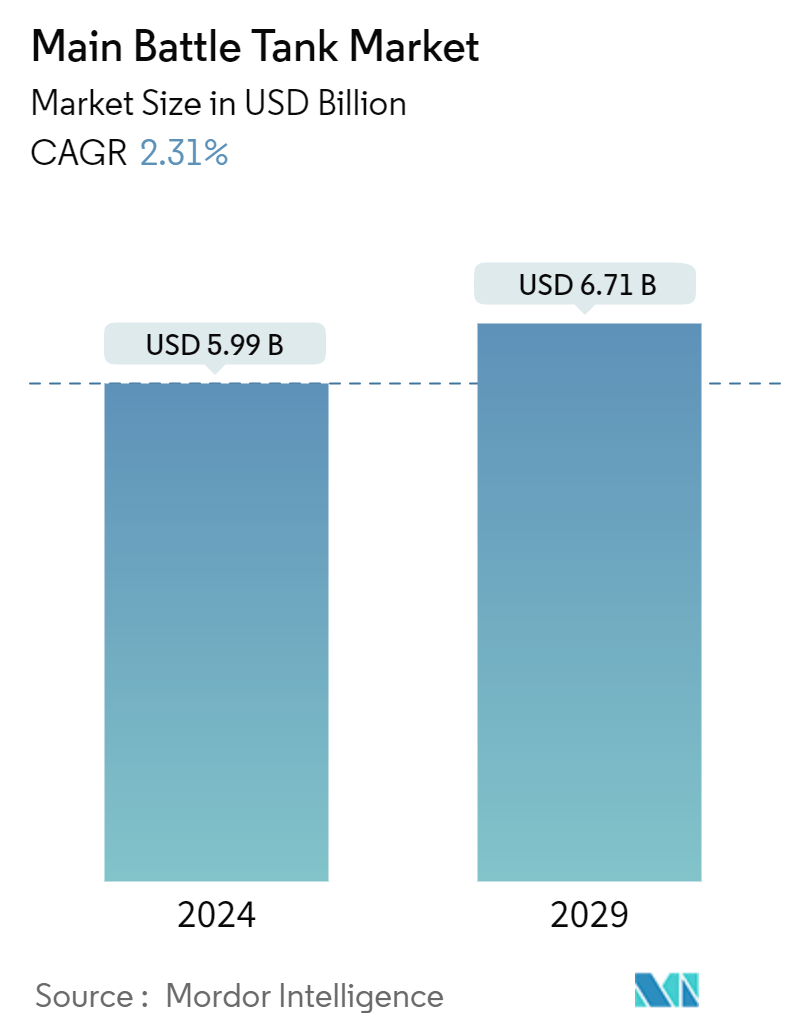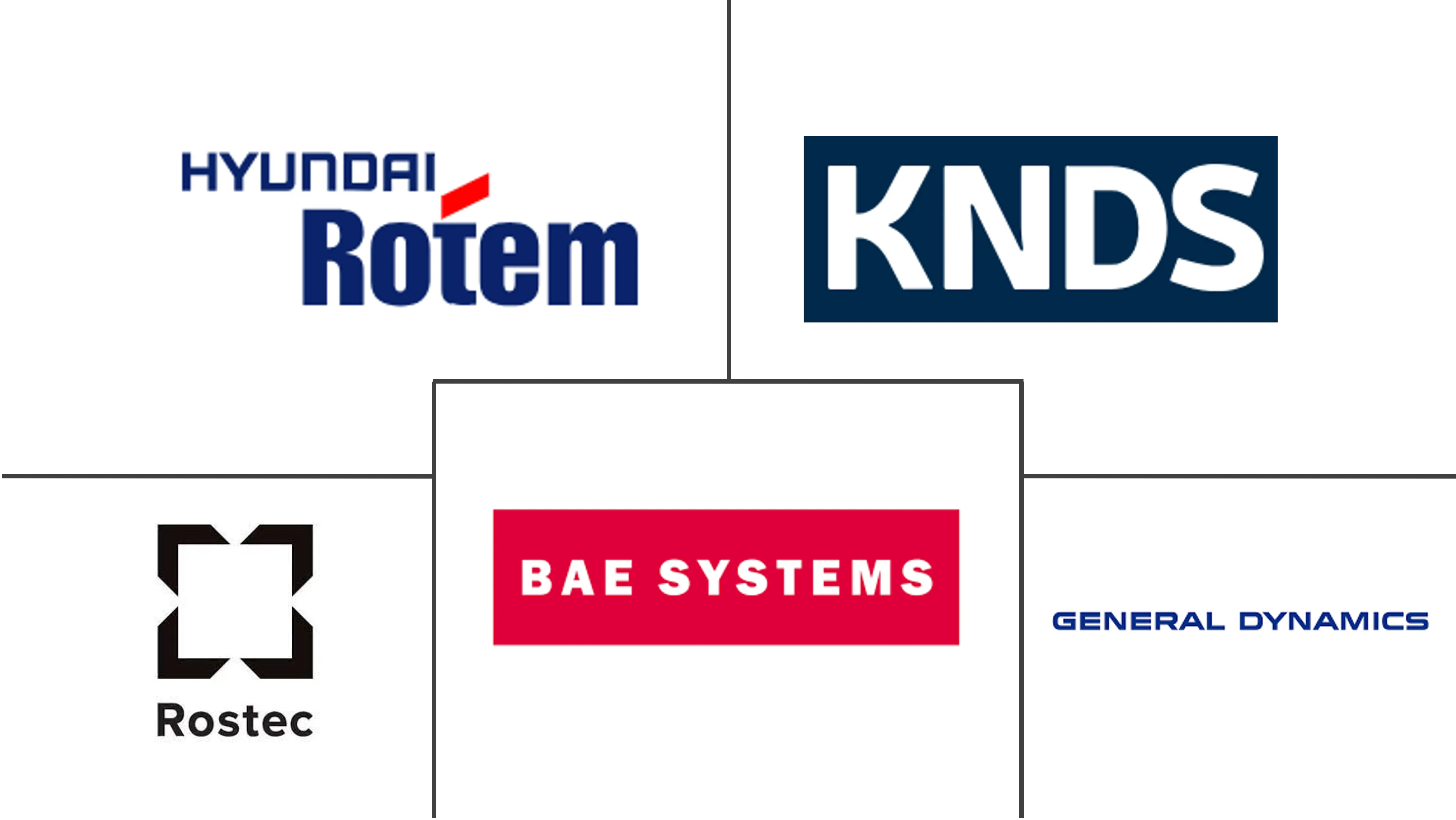Market Size of Main Battle Tank Industry

| Study Period | 2019 - 2029 |
| Market Size (2024) | USD 5.99 Billion |
| Market Size (2029) | USD 6.71 Billion |
| CAGR (2024 - 2029) | 2.31 % |
| Fastest Growing Market | Asia-Pacific |
| Largest Market | Europe |
Major Players
*Disclaimer: Major Players sorted in no particular order |
Main Battle Tank Market Analysis
The Main Battle Tank Market size is estimated at USD 5.99 billion in 2024, and is expected to reach USD 6.71 billion by 2029, growing at a CAGR of 2.31% during the forecast period (2024-2029).
Forecasts indicate a surge in main battle tank (MBT) procurements in the coming years. Heightened geopolitical tensions and border disputes across Asia-Pacific, Europe, and the Middle East and Africa are expected to fuel this demand. As existing MBT fleets age, nations are bolstering their ground forces by investing in next-gen battle tanks.
Traditionally, MBTs are notorious for their fuel consumption and emissions. However, with global environmental concerns mounting, governments and defense bodies face pressure to slash their carbon footprints. This push might steer them toward lighter armored vehicles or alternative technologies, potentially reshaping the MBT market.
Many emerging nations are embarking on comprehensive tank upgrade programs. These initiatives encompass enhancements to engines, weaponry, and situational awareness systems. The goal is to align their capabilities with modern standards, driving a notable uptick in the market's growth trajectory.
Geopolitical tensions and conflicts have consistently played a pivotal role in shaping global defense procurement. These tensions arise from various sources, including territorial disputes, historical animosities, resource competition, and ideological clashes. As nations face these challenges, they seek to bolster their military capabilities.
The market faces regulatory challenges related to international arms trade regulations, export controls, and intellectual property rights. Participation in global arms requires strict adherence to export control regulations and licensing requirements. Moreover, intellectual property rights protection and enforcement remain a concern for defense companies operating in the market, impacting innovation and technology transfer.
Main Battle Tank Industry Segmentation
Main battle tanks are pivotal assets in contemporary military arsenals. These tanks, designed to fulfill both maneuver and armor-protected direct-fire roles, are at the forefront of many nations' defense strategies. With escalating national security apprehensions, countries are increasingly investing in advanced battle tanks and enhancing their existing military hardware. These modern main battle tanks are typically grouped into armored units, often working in tandem with infantry forces. Moreover, they are frequently deployed in conflict regions, bolstered by surveillance and ground aircraft.
The main battle tank market is segmented by type and geography. By type, it is divided into light, medium, and heavy. The report also covers the market sizes and forecasts for the main battle tank market in major countries across different regions. For each segment, the market size is provided in terms of value (USD).
| By Type | |
| Light | |
| Medium | |
| Heavy |
| Geography | |||||||
| |||||||
| |||||||
| |||||||
| |||||||
|
Main Battle Tank Market Size Summary
The main battle tank market is poised for growth, driven by increasing geopolitical tensions and the need for military modernization across various regions, including Asia-Pacific, Europe, and the Middle East and Africa. As existing fleets age, countries are investing in next-generation battle tanks to bolster their ground forces. This demand is further fueled by territorial disputes and historical animosities, prompting nations to enhance their military capabilities. However, the market faces challenges due to environmental concerns, pushing governments to consider lighter armored vehicles or alternative technologies. Emerging nations are also undertaking comprehensive tank upgrade programs to align with modern standards, contributing to the market's growth trajectory.
The market is characterized by strategic partnerships among key defense manufacturers, such as General Dynamics Corporation, BAE Systems PLC, and Hyundai Rotem Company, which facilitate technology transfers and expand market share. European countries, including France and Germany, are focusing on acquiring and upgrading main battle tanks, with collaborations like the KNDS and LEONARDO alliance to develop the LEOPARD 2 A8 solution. The conflict between Russia and Ukraine has significantly influenced demand, as seen in Poland's substantial procurement of Abrams battle tanks. Additionally, countries like India and Italy are actively developing and procuring advanced tanks, reflecting a promising growth trajectory for the main battle tank market in the coming years.
Main Battle Tank Market Size - Table of Contents
-
1. MARKET DYNAMICS
-
1.1 Market Overview
-
1.2 Market Drivers
-
1.3 Market Restraints
-
1.4 Industry Attractiveness - Porter's Five Forces Analysis
-
1.4.1 Bargaining Power of Suppliers
-
1.4.2 Bargaining Power of Buyers/Consumers
-
1.4.3 Threat of New Entrants
-
1.4.4 Threat of Substitute Products
-
1.4.5 Intensity of Competitive Rivalry
-
-
-
2. MARKET SEGMENTATION
-
2.1 By Type
-
2.1.1 Light
-
2.1.2 Medium
-
2.1.3 Heavy
-
-
2.2 Geography
-
2.2.1 North America
-
2.2.1.1 United States
-
2.2.1.2 Canada
-
-
2.2.2 Europe
-
2.2.2.1 Germany
-
2.2.2.2 United Kingdom
-
2.2.2.3 France
-
2.2.2.4 Russia
-
2.2.2.5 Rest of Europe
-
-
2.2.3 Asia-Pacific
-
2.2.3.1 China
-
2.2.3.2 Japan
-
2.2.3.3 India
-
2.2.3.4 South Korea
-
2.2.3.5 Rest of Asia-Pacific
-
-
2.2.4 Latin America
-
2.2.4.1 Brazil
-
2.2.4.2 Mexico
-
2.2.4.3 Rest of Latin America
-
-
2.2.5 Middle East and Africa
-
2.2.5.1 United Arab Emirates
-
2.2.5.2 Saudi Arabia
-
2.2.5.3 South Africa
-
2.2.5.4 Rest of Middle East and Africa
-
-
-
Main Battle Tank Market Size FAQs
How big is the Main Battle Tank Market?
The Main Battle Tank Market size is expected to reach USD 5.99 billion in 2024 and grow at a CAGR of 2.31% to reach USD 6.71 billion by 2029.
What is the current Main Battle Tank Market size?
In 2024, the Main Battle Tank Market size is expected to reach USD 5.99 billion.

